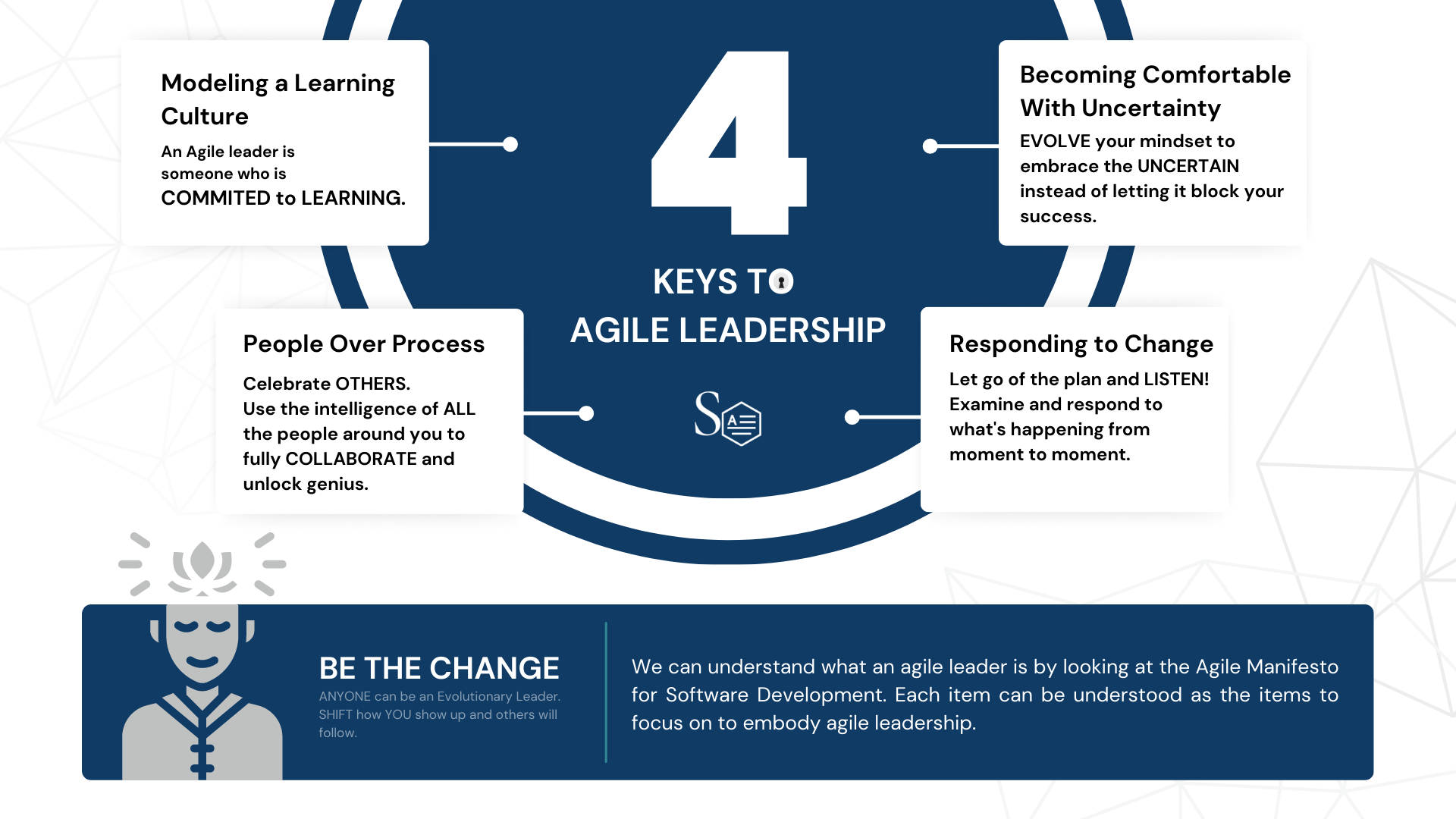In the current business environment, being quick and alert can be advantageous for a leader, especially when combined with intelligence and foresight. Agile leadership is a management style that emphasizes this quality, and it is becoming increasingly crucial in the fast-paced and ever-changing world of business. As we look forward to the future of business, this blog will dive into the concept of key Skills for Agile Leaders, its significance in the current business landscape, and how it can impact a company’s success, both now and in the future.
Who is an Agile Leader?

Agile leadership is not limited to a specific role within an organization. Instead, it’s a mindset that anyone can adopt to inspire positive change. Leadership reflects an individual’s character and how they show up, not their job title. To be a leader, people must choose to follow and be inspired by the person’s behavior, attitude, and treatment of others. Sometimes leadership involves proposing ideas, while other times, it means supporting others’ ideas. Asking questions and encouraging others to shine can also be signs of effective leadership.
1. Leading with Courage
“The greatest leader is not necessarily the one who does the greatest things. He is the one that gets the people to do the greatest things.” – Ronald Reagan.
The hallmark of great leaders is their ability to inspire courage in others through their actions and words. They have a clear vision of the future and are willing to work alongside their teams to make it a reality, even if it means taking personal risks or making sacrifices. In the face of adversity, these leaders take responsibility for their actions and give credit to their teams for their successes. They are fearless in taking on challenges head-on, even if it means facing angry customers or critical stakeholders. By leading by example, they instil confidence in their teams, who are more willing to take risks because they know their leader is there to support them.
2. Prioritizing Team Success
“Leadership is not a position or a title; it is action and example.” – Cory Booker
To prioritize the success of your Agile team, it’s essential to provide them with the right tools, coaches, and adequate time to adjust and improve. When your team encounters obstacles, it’s important to ask them what they’ve learned and how they intend to address it differently in the future while offering your support if needed. This reinforces the idea that progress is their responsibility and shows your commitment to continuous improvement. However, it’s important to be patient and remember that implementing Agile practices takes time. Focus on the long-term benefits of Agile for the team and the organization while providing them with the support they need.
3. Agile Leaders Embrace a Culture of Learning
“True leaders understand that leadership is not about them but those they serve. It is not about exalting themselves but about lifting others.” – Sheri L. Dew
Agile leaders understand the importance of listening and curiosity. While they may be knowledgeable and experienced in their product and customers, they recognize the value of a diverse, intelligent team that can challenge their assumptions and offer innovative ideas. It’s said that a leader can be measured by their followers. Do they surround themselves with people of character and conviction, or simply “Yes people”? Agile leaders prioritize attracting and leading a team of individuals who can challenge and push them towards success. They recognize their intelligence and talent alone will only take them far with followers.
4. Mastering Agile Leadership
“If your actions inspire others to dream more, learn more, do more, and become more, you are a leader.” – John Quincy Adams
Agile leaders excel in empowering their teams by providing support, removing obstacles, and encouraging autonomy to overcome challenges. They embrace servant leadership, which prioritizes the needs of others, shares power, and nurtures the development of their team’s skills and abilities to achieve their highest potential. Unlike traditional leadership, where leaders dictate orders, servant leadership emphasizes sharing power and helping individuals thrive.
5. Agile Leaders Put People First
“Leadership is not about being in charge. It’s about caring for those in your charge.” – Simon Sinek.
Agile leaders understand that their organisation’s success relies heavily on their team members’ engagement and productivity. Therefore, they go above and beyond to establish a work environment that promotes success. This includes promoting a healthy work/life balance and setting an example by taking time off and avoiding work-related communication outside of work hours unless it’s an emergency. Additionally, agile leaders proactively remove obstacles that may impede their team’s progress, such as outdated policies, capacity limitations, or uncooperative stakeholders. They also demonstrate vulnerability and transparency to build trust with their teams, allowing for open and honest communication.
6. Aligning the Entire Organization
“The task of the leader is to get their people from where they are to where they have not been.” – Henry Kissinger
A genuine Agile leader recognizes the importance of optimizing the entire organization, not just individual teams or departments. To successfully implement an Agile transformation strategy, it’s crucial to establish a clear vision or business goal and communicate it effectively, instill a sense of urgency among the team members, and appoint a group of competent leaders to execute the plan.
It’s important to remember that organisational success results from cohesive teamwork and efficient collaboration between different departments to deliver maximum customer value.
Be the Agile Change You Want to See
The notion that only those in positions of power or authority can make change is false. Agile leadership is not limited to specific individuals, as anyone can model it. Rather than lamenting the lack of agile leadership in others, individuals can start by changing their behaviors. By embracing the agile mindset and altering how they show up, anyone can make their workplace environment more agile, regardless of limitations or constraints. So, the only obstacle to living the agile mindset is oneself.

























One Response
It’s not my first time to pay a quick visit this web page, i am
browsing this web page dailly and take nice data
from here every day.